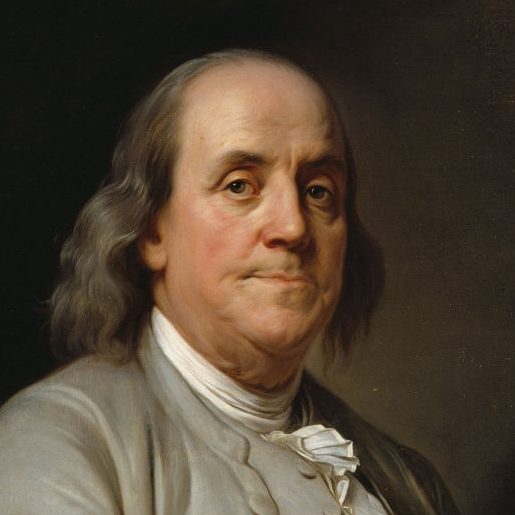Spy Master Dr. Benjamin Franklin was the Patriots
“Bridge Across the Atlantic.”
The Early Psychological Matrix of America’s 1st Patriot:
Benjamin Franklin was born in Boston Massachusetts in 1706. His father Josiah Franklin was a poor candle and soap maker, and Benjamin was the youngest son and the fifteenth child of a second marriage which totaled seventeen children. Benjamin’s father originally wanted him to become a preacher and sent him to grammar school. Shortly afterward he transferred to Mr. Brownell’s school where he excelled in writing, but not arithmetic. Due to the economic hardships of his struggling father, he ended his education at school when he was 10 years old, and returned to work at his father’s candle shop. This didn’t hamper young Franklin’s lust for education though. To help remedy his lack of monetary means for a proper school education, he self-supplemented his education by constantly reading every chance he got. Reading became his favorite pastime which led into intellectual debates with friends, and then by 1727, he founded the Leather Apron Club with like-minded friends who shared the “Spirit of Inequality.” Their goal was to improve themselves, and help other succeed within the community to become landed gentry. Originally, there was 12 members (Magic Number) who would be referred to in a vernacular street nickname, “Junto” which for the most part means join-in. The original members were drawn from a diversity occupations and nationality backgrounds. There was a cabinet maker, a surveyor, a general clerk, a bartender, and a few were printers who were business associates of Ben. All these people were afflicted by established British Parliamentary Laws which caused social class stratification.
Could the formation of this club be his 1st Patriot attempt (within the societal constraints) to circumvent the established parameters of British class stratification? I would like to view this as an early psychological foundation stone to his later Patriot movement.
Since, childhood Ben had dreams of being a sailor so he can take part in the big adventure that only maritime life could offer; but unfortunately his father didn’t approve because his older brother Josiah went out to sea and never returned. Since, Benjamin loved reading and had an aptitude for writing, his father arranged that he learn the printing trade under the tutelage of his older brother James at his printing shop in Boston. James was known to be an outspoken character who had a unique impression on his younger brother. He was known to vocalize his opinion freely, and he constantly exposed his rebellious attitude toward both the British Parliament’s governance, and the theocratic approach of governing which was popular in the New England colonies. James ended-up being imprisoned for his criticism and young Ben ran the paper himself for a time.
Could this have laid Ben’s early childhood psychological make-up to be an advocate of the separation of church and state? I would like to say yes as a starting block, but most likely it will be fueled later through his education in the St. John’s Masonic Lodge in 1730, and then in England through the Order of Knights of St. Francis. These two social clubs unlike his founded Junto club would have offered young Benjamin the exposure to the religious political turmoil of 18th Century Scotland and England.
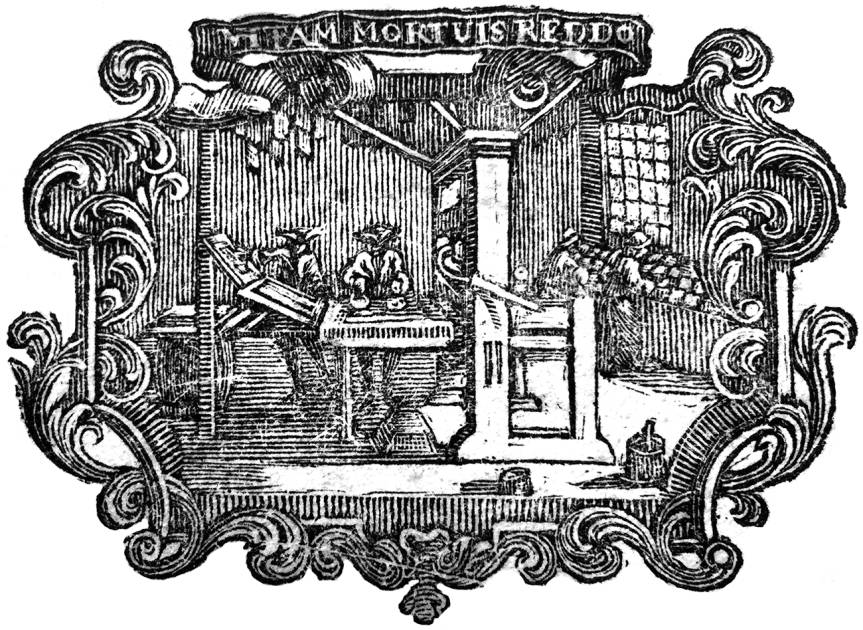
Samuel Palmer printer’s ornament
Used by Benjamin Franklin in his pamphlet
A dissertation and Necessity, Pleasure & Pain
Like a parent his older brother James understood the real nature of social class stratification, and took steps toward dissolving Benjamin’s impecuniousness societal class status. By appealing to his love of reading unattainable books, and with the help from a (Secret Jacobite sympathizer) Sir William Keith IV, the colonial governor of Pennsylvania it was arranged that young Benjamin (at 18 years old) would travel abroad to London and work as a pressman and compositor in the printing office of Samuel Palmer in 1725, and then later at the office of John Watts in 1726. During his second month at Palmers in 1725, Franklin set the type for the third edition of William Wollaston’s, “The Religion of Nature Delineated.” After objectively reading one of the printed copies, Franklin boldly put forth his counter argument in defiance of the writer in a pamphlet called, “A Dissertation on Liberty and Necessity, Pleasure and Pain.” In this era a social etiquette was expected from people, and there were grave consequences to individuals that didn’t conform to the established graces of polite society. Young Benjamin’s argument also bordered on atheistic, and realizing his error and boldness he quickly attempted to retrieve and destroy all one hundred copies of the pamphlet. Unwittingly, it had attracted the favorable attention of Dr. William Lyons, who saw merit in young Ben’s counter argument and introduced Franklin to a circle of radical thinkers including Bernard de Mandeville.
The exposure to English life must have influenced young Ben’s bold outspoken personality, but did not change the rebellious nature and political views that he was exposed to by his brother James in his adolescent life. Intellectually he never accepted his father’s Calvinist theology either, and opened himself to the more secular world view of Sir Isaac Newton and John Locke who gave heed to societal social contracts.
Upon his return to the states he took the necessary steps to elevate his social status and increase his education by forming the Junto Club and St. John’s Masonic Lodge in 1730. He set-up shop in Philadelphia, Pennsylvania as a printer / publisher and catered in a way to certain gentry schools of thought and social trends of the era. He would often cater to certain nationalities which would even include a newspaper in German geared to the Pennsylvania Deutsch. Understanding that social mobility was a driving key to further his social standing and his economic fortune, he later became a member of the Philadelphia Municipal Council in 1746, and by 1750 he became a member of the Philadelphia Assembly.
As all men who grow in social and economic stature, Benjamin Franklin’s unique understanding of colonial current events within the colonies caused him to take an active role in the French-Indian War campaign of 1755. Just like George Washington’s native birthright status as subordinate to British born citizens, Franklin was also unfairly hampered by the century old British law which limit his military rank to rank of Colonel in the British Army. (There has been eye witness accounts of him wearing a British Army uniform, but doubtful he would have been given a signed commission by George II.) Like George Washington, Benjamin Franklin was caught-up in a social class status predicament. He was able to move up economically, but was curtailed in social class authority status due to Parliamentary Laws of natural born citizenship outside of Scotland and England. In 1757, the Penn family had maneuvered him as the Pennsylvania Agent in London through appointment even in the face of fierce resistance of the British-born gentry living in Philadelphia. This would be a personal Political flash-point which would feed into other colony societal inequalities. These two examples could be viewed as, “part of the fuel” to give him the personal grass-roots of the Patriot movement toward Equality.
Even though Benjamin Franklin’s first trip to London was encouraged by a Secret Jacobite sympathizer Sir William Keith IV, the colonial governor of Pennsylvania, it was probably his second transatlantic trip where his so-called, “Conversation” (In secret to himself ) became complete into Scottish Royal Culture, Scottish thought and philosophy. This was no transmogrification to Scottish-Jacobite thought of rebelliousness, it had a build-up of consequential political acts that worked through like-minded friends in America and festered within England’s social clubs. Even though Franklin’s personality had many dynamic parts to make him America’s first patriot, statesman, diplomat, publisher, writer, philosopher, inventor, and scientist; we are going to only look at two aspects of his life which contributed to his character of who he was to ultimately use Scottish Propaganda as his vehicle before, during, and after the American Revolution.
The first was his lack of early education, and the second was his social mobility drive he developed after establishing himself in Philadelphia upon his return trip from his apprenticeship in London. It is commonly believed by academic scholars (undocumented by Franklin himself) that John Locke’s “Foundation of Human Knowledge and Understanding” (An essay concerning human understanding); and Joseph Addison’s “The Spectator” had an influential effect contributing toward his perception of society, and resulted in his outspoken character traits. This might be considered the building blocks, but not strong enough to gear his optimism and choice to support Scottish-Jacobite thought. I believe this comes from the social status mobility gained through his doctorate from the University of Saint Andrews! Yup, I bet you didn’t know it was a Scottish degree! In February of 1759, the University of St. Andrews conferred upon Benjamin Franklin an honorary degree of “Doctor of Laws” noting for his writings on electricity. Aside from being known as a founding father, he is most noted for being a scientist (unless your a Hellfire / Ouroboros club brother, we will get to that soon..lol). This would catapult Franklins social standing to “Rock Star Stardom” regardless of the social class restrictions placed upon him because of his birth status. From this point forward he would be called, “Dr. Benjamin Franklin.” In the later half of the 18th century, Scotland was growing in importance in the sciences and arts. Even though history makes point his 20 year friend from London William Strahan convinced him to go to Edinburg, he must have realized the personal benefit of notable intellectual aristocrats he would be introduced too. Noted aristocrats who considered themselves part of the New Age of Reason (French) in Scotland like, Lord Kames (noted Genius), Sir Alexander Dick, Professor Adam Ferguson, Professor Munro, Dr. Joseph Black professor of chemistry, Dr. Russell professor of physics, Dr. Cullen, Dr. Robertson, David Hume, and Adam Smith. These are all a very important cast of characters who had considerable political and economic influences on society and it’s development to which we term, “Scottish Enlightenment.” Franklin was even noted as sending to Philadelphia Kames, “Law Tracts and Principles of Equality” and “Elements of Critisism.” (That is a BIG WOW if you are familiar with these writings. When this hit John Adams legal hands these Scottish equality law based principles must have been wildfire in Philadelphia amongst the Gentry of Revolutionaries). With his doctorate in hand he was admitted to the “Guild Brethren of the City of Edinburgh;” and at a prestigious ceremony presided over by the world renowned Lord Provost Drummond considered father of the New Town in Nor Loch (A section of Edinburgh known as the Loch).
With these new Scottish nobility associations (Penn Faction?) and established aristocratic and landed gentry relationships in London, Dr. Benjamin Franklin must have been on cloud 9! By the time of the breakout of the American Revolution his reputation was known throughout the world. He was even partly chosen as, “1st Minister to France” because of this fact, and the French aristocrats of Versailles adored and fell-all-over the man who tamed lightening from the sky, and brought it back to earth. This enabled his to ceremonial present his credits to Louis XVI in an official capacity regardless of his citizenry class (There is an exquisite drawing of Franklin presenting his credentials to Louis XVI, by Gabriel de St Aubin).
But this is the man he wanted to be distinguished as in the public view. This doesn’t account for his true nature of his character to become America’s 1st Revolutionary Patriot. What we have established is the intellectual part of the tool box was formed by Scottish & English Gentry from Aristocrats to University elites. Historians of Benjamin Franklin could directly point to three crucial pieces of legislation: the Proclamation of 1763, the Sugar Act of 1764, and the Stamp Act of 1765 as sort of breaking an unofficial social contract which could have swayed his sympathies for the colonists plight; In-which he famously address at the bar of the House of Commons, and was suppose to have been extolled in aristocratic circles in England, France, and Scotland.
Now we must look into the side of his character which made Benjamin Franklin a Revolutionary Propagandist. As with all colonists, Benjamin Franklin wanted to be a British citizen of the Gentry Class. He grew up in the realization that the Gentry class benefited from a stratified society, and the ways in which people interacted with one another reflected their relative social positions. This was not only how something was said, but when it was said, was reflective of the social positions of the speakers. He grew-up poor with no birth or bloodline advantages of a parental marriage. For example, it was not proper for someone of a lower social rank to offer a greeting to a person of higher rank without having been first addressed by that person. Nor was it proper for a social inferior to end the conversation. Secondly, as we mentioned earlier in Franklin’s determination to become part of the Gentry class was a driving force behind his success. He understood there was some fluidity between the the levels of society, but money was not enough to lift a person to a higher level as he continued to experience living in a stratified class system. In 1727, Franklin formed the Junto Club which consisted originally of “12” members (a group of friends) to provide a structured form of personal growth and mutual improvement. Since, deportment was customary in polite civilized society, there was a need for the newly landed gentry to gain respect regardless of ones lower birth social rank (Deportment in the 18th century included dress, bodily carriage, and the use of polite forms of conversation). In 1730, Benjamin Franklin became a member of Philadelphia’s Saint John’s Lodge which met on the 2nd floor of Tun’s Tavern (This is also where the Junto Club met). Freemasonry provided Franklin with his first real entrance into Scottish Royal Culture by Masonic education. It also provided a vast array of trustworthy brothers (incl. later G. Washington, J. Madison, Voltaire, and Thomas Jefferson) which undoubtedly helped form business partnerships, advance his scientific ideas, and then later develop, initiate, and implement Revolutionary War strategies.
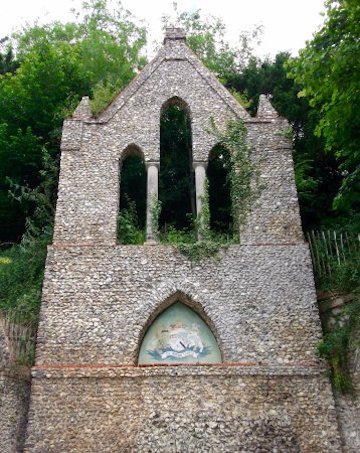
The Hellfire Club
Birds of a feather flock together, you are who you hang-out with. As we grow older most of us believe there is merit to these sayings as we take stock in other individuals friend choices. Most of us have friends that others ask, how is he friends with that person? The answer is there is a deep seated psychological connection that others don’t readily see, but we subconsciously or consciously recognize these traits and identify them. So, lets look at who Benjamin Franklin was spending most of his free time with in England after those polite society dinners. Sir Francis Dashwood the founder of multiple social clubs ( 1738, Society of Dilettanti, 1746 Order of the Knights of St Francis) in England for the British political aristocrats who like to drink in excess; take part in socially perceived immoral acts with women, and do ancient pagan rituals usually at the beginning of the meetings as a benefit rite of membership. Dashwood managed to combine public service with private pleasure in a manner which no other politician had ever done in polite society nevertheless emulate uncaringly public manor.
he was first Chancellor of the Exchequer, then Postmaster General, and he and Franklin, as Postmaster General of the American Colonies, drew up a plan of reconciliation to avert the impending war—a plan that was eventually undone by intransigents on both sides. But, all, Sir Francis’s friends — “the best company in the world” to whom Franklin alluded—they were the 45 or so Knights of St. Francis of Wycombe, better known as the HellFire Club,
Among them were the Earl of Sandwich, First Lord of the Admiralty; George Bubb Doddington (Lord Melcombe Regis), friend of the Prince of Wales; Thomas Potter, Paymaster General and unfrocked priest; John Wilkes, Member of Parliament and Lord Mayor of London; William Hogarth, the painter, and at least four other prominent Members of Parliament.
The host, Sir Francis Dashwood, had credentials enough—he was first Chancellor of the Exchequer, then Postmaster General, and he and Franklin, as Postmaster General of the American Colonies, drew up a plan of reconciliation to avert the impending war—a plan that was eventually undone by intransigents on both sides. But, all, Sir Francis’s friends — “the best company in the world” to whom Franklin alluded—they were the 45 or so Knights of St. Francis of Wycombe,
John Wilkes, a secret Jacobite who paid tribute to Charles I & II resistance and restoration propagandist. who was very outspoken against the Hanoverian rule, and sought a better social contract through societal changes.

John Wilkes one of the original 12 members of The Friars of St. Francis of Wycombe
45 members by the time it grew it got to 45 members after the uprising of 1745 . All the propaganda art usually carried the revolutionary number 45.The steward of the Hell‐Fire Club from its inception in 1746 was Paul Whitehead, a minor poet and major carouser. The objects of the club were wine, women and profane song.rites of black magic. Members wore monklike robes and were each allowed to introduce one lady “of a cheerful, lively disposition” who, under the rules, was dressed up as a nun and obliged to wear a mask. The man serving as Abbot (the office was held in rotation) organized the feasting and revels and had first choice of women.
The education and repetition of these ancient rituals had an effect which we believe contributed to his psychological propaganda warfare against the British aristocracy in the American Revolution. Prior to the founding of the Hellfire Club in England, Dashwood went to Florence, Italy where he met Prince Edward Stuart the true heir to the Scottish throne. The Bonnie (who was said to be the secret Grandmaster of all Masonic Scottish-Rite lodges – Yes, Scotland, England, France, and the American colonies through Strict Observance) who without a doubt had far reaching associations with Masonic and neo-Templar secret societies “Sponsored” Dashwood into the Masonic Lodge. We believe the snake propaganda was reintroduced from Charles I & II by the Bonnie and Dashwood used it as a secret Jacobite Spy when he founded his Order of Knights of St. Francis in 1746. Initially, the Knights met at the George & Vulture public house in Cornhill in the City of London. The meeting room was dominated by an everlasting “Rosicrucian Lamp.” This was a large crystal globe encircled by a Gold Serpent with its Tail in its Mouth. The globe was crowned with a pair of silver wings and was suspended in chains in the form of twisted snakes. This Gnostic design of the “Rosicrucian Lamp” which incorporates the theme of the snake and the dove also appeared on the meeting halls front door! (Time line jump to 1799, 1 of the only 3 sanctioned designs of George Washington memorial Urn buttons is with a Dove on top, Peace or Masonic-Gothic Tribute?)
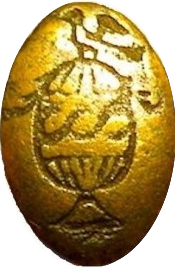
In 1751, Dashwood ended-up leasing the Medmenham Abbey on the Thames near Marlow. This was originally a 12th century Cistercian monastery which he converted into a contemporary English Tudor Manor house. He originally had 12 members which grew to 45 by the uprising of 1745. His renovation of the Abbey kept with the 18th century Gothic revival going on in Britain. Dashwood’s interest in keeping with Scottish-English history was also reflected by keeping his Knight’s Order to 12 members. This was reflective of the Order of the Garter / Order of the Thistle. We know from accounts that Dashwood and his Knights Order had a practicing fascination with pagan gods and goddesses, and was reflected in their lodge’s theme decorations and rituals which used Scottish Royal Culture motif metaphors from both ancient Egypt and Rome. The new manor at West Wycombe even had a stained glass window specifically made for above the front door that says, “Do as thou will.” The gardens boasted a naked statue of Venus, and a well-endowed statue of Priapus. Inside the Abbey, the dining room had flaunted two standing figures. One of the Egyptian god (of silence) Horus with his finger to his lips. The second was the ancient Roman Goddess Angeronia who relieved men of their pain and sorrow. (In Freemasonry these two deities are known as, “The Guardians of Secrecy”). These statues represented the lifestyle of the Order, and served as subtle reminders that nothing that was said or went on in within their walls (ritual practices & womanizing) would be spoken about outside in society.
Sir Francis Dashwood
Founder of the Society of Dilettanti, & Order of the Knights of St. Francis.
Snake graph chart
Dashwood’s interest in pagan gods and goddesses was reflected in the decorations for his house at West Wycombe
All these social clubs in this era had a common denominator of being uncultured sine nobilitate landed gentry or Jacobites that shared the same ritualistic Scottish Royal Culture and Judaeo-Christian religious connotations, values, and pagan ritualistic themes in their meetings.
Night after night Dr. Benjamin Franklin would frequent and take part as an active member in a club called, “The Order of the Knights of West Wycombe (The Friars of St. Francis of Wycombe) in a ritual room dominated by a large crystal globe encircled by an “Ouroboros” – A gold serpent with it’s tail in it’s mouth!! This globe was surmounted with a pair of silver wings, and was suspended in chains in the form of a twisted serpent. Constantly night after night frequenting a club with Pagan Gods and Goddess that were architecturally expressed as a replica of the classical temple of Bacchus.
This clubs most certainly played as Franklin’s Scottish Revolutionary ideological entrance and adoption into his psyche of the Jacobite Scottish Royal Culture. The secret club rituals performed by the members undoubtedly contributed to his understanding and education of the representation of ancient world symbols (of the snake too) and their representational meanings. There is No Other Place in the world Benjamin Franklin would have visited to be educated in this type of history! Meaning, this frequent exposure became part of his personality make-up (Just as his known womanizing) which he would ultimately use later in his propaganda warfare starting in 1765, with his Join or Die 8 Segmented Snake cartoon in protest against the British Stamp Act.
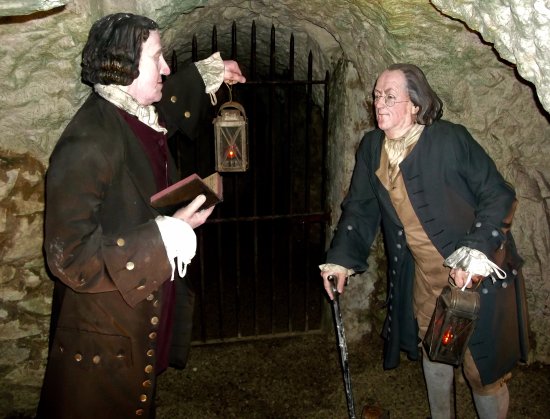 The Monks of Medmenham, Sir Frances Dashwood & Benjamin Franklin
The Monks of Medmenham, Sir Frances Dashwood & Benjamin Franklin
I think these two individuals clicked on all personality levels, and shared a unique bond of commonality and struggles of social class stratification of the newly landed gentry of humble beginnings. Dashwood was a son of a wealthy businessman, but only got his title by marrying into the aristocracy. Franklin obtained his entrance into the landed gentry through his honorary doctorate from the University of Saint Andrews. In this era, both of these men would still be considered by the pretentious snobs of the Blue-Blooded aristocrats as inferior “Landed Gentry” regardless of their personal merit of accomplishments or marriage. By the time Benjamin Franklin returned to America he had a tool box of Scottish Royal Culture, and practicing knowledge Jacobite propaganda through club membership and social activism.
********
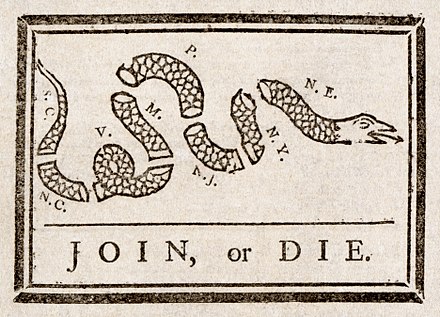
************* *************
The Eight Segmented Snake & Rattlesnake Propaganda
At some point, Benjamin Franklin must have made a beneficial agreement with Scottish Elite Class ( Council of Enlightened Revolutionaries) and worked with Robert Scot’s umbrella artisans to manipulate the propaganda war against the British. This root step would lay the tracks for the foundations of the New Republic. His decisive 1754, Join or Die statement published in the Philadelphia Gazette was a colony representation, but then manipulated by Robert Scot and his Philadelphia Artisans to parallel with their Scottish Royal Culture’s use of the Egyptian’s snake symbol of propaganda. The American Rattlesnake with Scottish use roots to the House of Stuart would served as a rally-cry for the patriots.
The Anglo Protestant Enlightened Revolutionaries will bring their war through a substructure of the bibles Great Architect of the Universe design. By using Gary Gianotti’s Scottish Royal family research, we were able to tie Robert Scot’s genealogy to the Sinclair family. This would reasonably explain his knowledge and authoritative rights to use Scottish Royal Bloodline symbols in his newly developed transforming art for the New Republic. This also would be the main reason why other accomplished artisans of the era would naturally fall under his directorship umbrella in creating federal insignia art. By being a “Hidden Master,” Robert Scot could act on behalf of the Scottish Enlightened individuals by using several different nationality artisans, but their work could only be sanctioned by Robert Scot in the end. Most likely, he provided permitters in a consultation or manipulated the drawings afterward and before congressional review.
By the 1770’s, Benjamin Franklin’s was able to incorporate the Scottish elite’s new societal framework of the Grand Architects Design along with the promotion of “New Era Ideals” in concert with his philosophy of nature and science. Earlier in 1754, he was able to place multi-deep seated meanings within his continuing propaganda use of the (8) Eight Piece Segmented Snake Symbol. This snake symbol was able to transform from it’s original message into an American Propaganda vehicle which held a Liberty, Independence, and Unity message against British Parliament Laws. As different aspects of society were affected by the British Laws, Franklin would alter to fit the patriot message and transform the connotation. Dr. Franklin waged his propaganda war through newspapers, journals, and other published vehicles. This offered the “Cloak N Dagger” secrecy for the Patriot movement by providing Dr. Franklin with anonymous written journalism. No one wants to be hung in the town square….. lol
By Dr. Franklin’s continually using his eight piece segmented snake, one could say it could parallel the Enlighten Visionaries use of the Scottish Royal Culture Aegyptia Anguis / Rattlesnake metaphor. The simultaneous use of both symbols in written publications and Masonic lodges provided a reinforcement to the aggrieved subordinate class of colonists. The Scottish Royal Culture propaganda symbols such as, “The Rattlesnake buttons and Liberty Pole & Cap,” originate through the House of Stuart’s lineage starting with the Egyptian Super Scholars, Phoenicians, and Romans with contributing religious integrations. Sprinkled in for balance..lol
Here begins the incorporation of the “Egyptian Metaphorical backed Symbol of the, “Aegyptia Anguis” into colonial pre-revolutionary Columbia (America). The Rattlesnake symbol’s true meaning and intended use was purposefully hidden and disguised through allusion to the average (uneducated) colonial citizen. In orchestration with other propaganda symbols taken from various ancient cultures (including the Liberty Pole & Phrygian Cap), Dr. Benjamin Franklin was able to facilitate a revolutionary patriot message for the Cause with the collaboration of the Scottish Gentry (Enlightened Revolutionaries) and their agenda of providing a new societal construct (Grand Architect Design) for a new republic.
These propaganda symbols would be cultivated and disseminated by Scottish Masonic Lodge Members, and revolutionary groups like the Sons of Liberty. This would not be a tidal wave change, but an accumulation of events that would strengthen the undercurrent revolution toward the dissatisfaction of British Parliament Laws. I cannot know for sure, but the time taken by designing the Grand Architect Design and culmination of events I would estimate a little more then 22 years. So, it should be reasonably assumed that Dr. Benjamin Franklin’s participation in underground networks, and his interactions with other social climbing colonists through their neighborhood Masonic lodges, along with clubs like, “Junto” would have provided an avenue to add onto the patriot ranks of the Revolutionaries. Through these avenues Dr. Franklin was able to introduce a series of intellectual New Era Ideals and propaganda based in the Allusion through “Science based Idealism.” This in-turn would have probably viewed as, “The New Ideals” for the New Republic.
My personal thoughts: Maybe, it is not the Point of when Aegyptia Anguis was introduced. Maybe, it wasn’t the choice of just one person or group. Analogy, If I am sitting in a room full of men that share the all the same Judaeo-Christian religion, sharing colonial culture and oppression of 2nd class citizenship, naturally everyone would have the same historical symbols in mind. There would be automatic historical representation to everyone without the need of further introduction of Aegyptia Anguis. There is no new symbols or metaphors to make up for a repeated history. It would only be a natural extension of what we would all use and see automatically because our fathers, fathers used them before them.
Benjamin franklin was able to harness these ancient religious virtues of Providence not understanding truly how the (Enlightened Revolutionaries) Scottish Gentry were incorporating their True meanings from history. Franklin, not being enlightened himself through his own self awareness, he was just a very educated man understanding the true meanings without the gift of true self enlightenment. As Franklin, educated scholars can understand Enlightenment, but they miss the “Magic” because they are told through rationality of a continually building education of enlightenment ideas from previous mistaken avenues by men. Meaning, if someone teaches you something, you miss the magic of learning it on your own. With enlightenment it is a series of lessons integrated at once for a much bigger understanding. Best I can say it.
